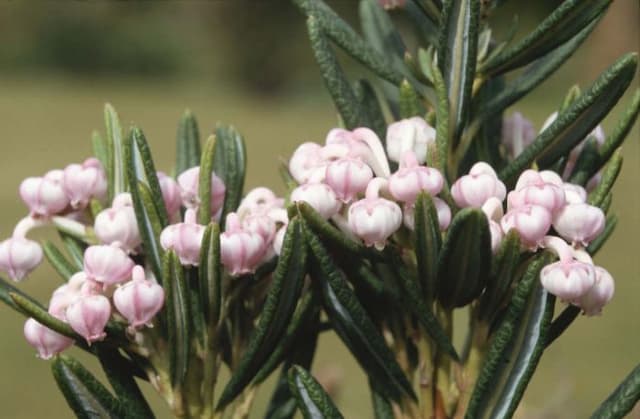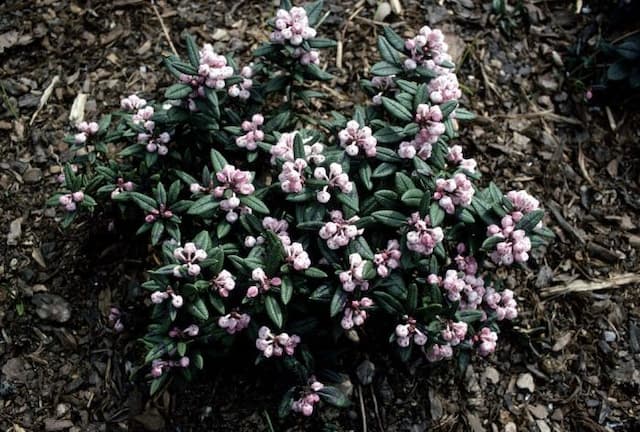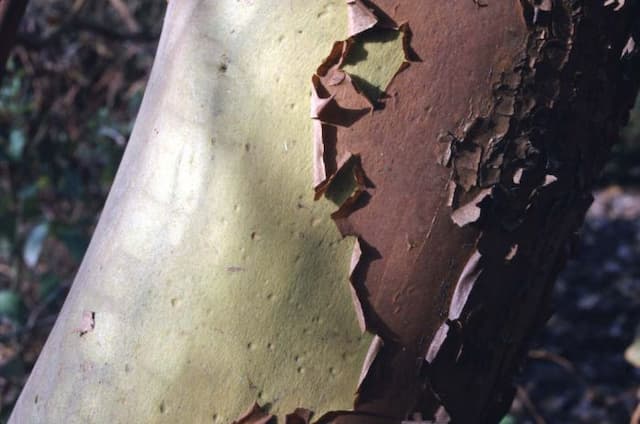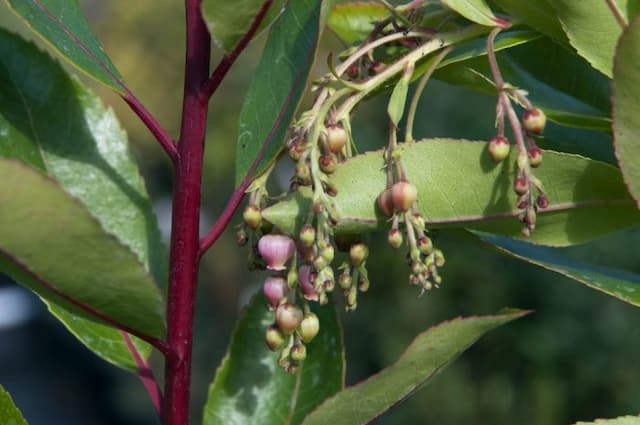Himalayan Lantern Agapetes 'Ludgvan Cross'

ABOUT
Agapetes 'Ludgvan Cross' is a striking ornamental plant known for its unique and attractive features. This plant bears a resemblance to small, hanging lanterns or baubles. Its most prominent feature is the tubular flowers that dangle from the arching stems, showcasing a spectacular blend of colors. The flowers are usually a mix of red and yellow hues with intricate patterns that may include spots or stripes, giving them an exotic and vibrant look. The foliage of Agapetes 'Ludgvan Cross' consists of shiny, evergreen leaves that are lance-shaped and add to the plant’s overall gloss and texture. These leaves provide a lush backdrop for the profusion of flowers, which creates a beautiful contrast against the greenery. This contrast is notably appealing throughout its blooming periods. The plant has a somewhat scrambling or spreading habit, often with numerous branches that contribute to its attractive shape and form. The branches bear the weight of the blooms elegantly, sometimes creating a cascading effect that enhances the visual impact of the plant. The structure of the plant allows for an impressive display when it's adorned with the flowers, making it a favorite for ornamental gardening and decorative purposes. Agapetes 'Ludgvan Cross' is a hybrid plant that adapts well to various conditions, and its remarkable appearance makes it a popular choice for gardeners looking to add a touch of the unusual and the exotic to their plant collections. The harmonious blend of colors, textures, and the charming shape of the blooms is what sets the 'Ludgvan Cross' apart, making it a captivating spectacle in any setting where it is grown.
About this plant
 Names
NamesFamily
Ericaceae
Synonyms
Ludgvan Cross, Himalayan Lantern
Common names
Agapetes 'Ludgvan Cross'.
 Toxicity
ToxicityTo humans
Agapetes 'Ludgvan Cross', commonly known as Himalayan Lantern, does not have widely documented or well-known toxic effects on humans. There is limited information available on the toxicity of this particular cultivar. However, it is always advisable to exercise caution and prevent ingestion of any plant parts if their toxic profile is not well established. If you suspect poisoning from any plant, seek medical attention promptly.
To pets
Himalayan Lantern, when it comes to the toxicity to pets such as cats and dogs, there is also limited information available specifically regarding the Agapetes 'Ludgvan Cross' cultivar. In the absence of concrete data, it is generally recommended to keep this and any unknown plants out of reach of your pets to avoid any potential risk. Should your pet ingest any part of this plant and you notice any unusual symptoms, please contact your veterinarian as a precaution.
 Characteristics
CharacteristicsLife cycle
Perennials
Foliage type
Evergreen
Color of leaves
Green
Flower color
Mixed
Height
4 feet (1.22 meters)
Spread
2 feet (0.61 meters)
Plant type
Shrub
Hardiness zones
9
Native area
Himalayas
Benefits
 General Benefits
General Benefits- Ornamental appeal: Agapetes 'Ludgvan Cross' has attractive, pendant, urn-shaped flowers and evergreen foliage, making it a beautiful addition to gardens.
- Attracts wildlife: The flowers produce nectar, which can attract hummingbirds and other pollinators, promoting biodiversity.
- Compact size: It is suitable for small gardens or spaces due to its relatively compact growth habit.
- Potential for hanging baskets: Its cascading branches and attractive flowers make it an excellent choice for ornamental hanging baskets.
- Low maintenance: Once established, it requires minimal care, making it convenient for gardeners with limited time.
- Adaptability: It can adapt to a range of soil types provided they are well-draining, allowing for diverse planting scenarios.
- Year-round interest: Evergreen leaves and periodic flowering provide visual interest throughout the year.
 Medical Properties
Medical PropertiesThis plant is not used for medical purposes.
 Air-purifying Qualities
Air-purifying QualitiesThis plant is not specifically known for air purifying qualities.
 Other Uses
Other Uses- Cultural Symbolism: In certain cultures, the Agapetes 'Ludgvan Cross' may be used as a symbol in ceremonies and traditions owing to its beautiful and unique flowers.
- Photography: The striking appearance of the Agapetes 'Ludgvan Cross' makes it a popular subject for photographers, especially plant and macro photography enthusiasts.
- Education: Botanical gardens and educational institutions could use this plant as a teaching tool for horticultural students or in lessons about epiphytic plant species.
- Collector's Item: Among plant collectors, the Agapetes 'Ludgvan Cross' is highly valued for its rarity and unique characteristics.
- Gardening Challenges: The plant can be used in gardening challenge competitions where growers aim to cultivate difficult or unusual species successfully.
- Illustration and Art: The unique form and color of the plant can inspire artists and serve as a model for botanical illustrations and artwork.
- Eco-friendly Events: As an ornamental piece, the Agapetes 'Ludgvan Cross' may be used in events aiming to promote sustainability and biodiversity.
- Bonsai and Crafting: Some gardening enthusiasts might try to train Agapetes 'Ludgvan Cross' plants into bonsai form or use its parts in crafting natural jewelry or decorations.
- Thematic Gardens: It can be featured in thematic gardens, such as those designed around the concept of 'Himalayan flora' since the Agapetes genus is native to the Himalayas.
- Retreat Experiences: This plant could be incorporated into retreat centers for its serene and exotic look to enhance the peaceful ambiance of the surroundings.
Interesting Facts
 Feng Shui
Feng ShuiThe Agapetes 'Ludgvan Cross' is not used in Feng Shui practice.
 Zodiac Sign Compitability
Zodiac Sign CompitabilityThe Agapetes 'Ludgvan Cross' is not used in astrology practice.
 Plant Symbolism
Plant Symbolism- Endurance: Agapetes 'Ludgvan Cross' is known for its resilience and ability to thrive in various conditions, symbolizing the human capacity to endure challenges and persevere.
- Connection: The intertwined growth habit of this plant can represent the interconnectedness of people and the strength of relationships that bind individuals together.
- Adaptability: This plant's versatility in different environments suggests the importance of being adaptable and flexible in life's various situations.
- Radiance: With its striking appearance and bright floral displays, Agapetes 'Ludgvan Cross' symbolizes joy, positivity, and the radiant beauty found in the world.
 Water
WaterThe Himalayan Lantern needs to be watered moderately, ensuring that the soil is kept consistently moist but not waterlogged. During the active growing season in spring and summer, water the plant when the top inch of soil feels dry, which may be approximately once a week. Depending on the size of the pot, this could mean using about 16-24 ounces of water. However, in the cooler months of fall and winter, reduce watering frequency to every other week, as the plant's water needs decrease.
 Light
LightThe Himalayan Lantern thrives best in bright, indirect light conditions. It should be placed in a spot where it can receive plenty of light but is shielded from the harsh midday sun. A north or east-facing window would be an ideal location, as it will provide the diffused light this plant prefers.
 Temperature
TemperatureThe Himalayan Lantern prefers to be kept in a temperature range of 50-75°F. It can tolerate a minimum temperature of around 45°F but is not frost-hardy and should be protected from temperatures below this. The ideal temperature for this plant is on the warmer end of its range, avoiding sudden temperature fluctuations and drafts.
 Pruning
PruningPruning of the Himalayan Lantern is primarily done to maintain its shape and remove any dead or damaged growth. It's best to prune the plant in the early spring before new growth commences. Light pruning can be done throughout the year as needed. Deadheading spent flowers can encourage further blooming.
 Cleaning
CleaningAs needed
 Soil
SoilAgapetes 'Ludgvan Cross', commonly known as Himalayan Lantern, thrives in well-draining, acidic soil with a pH between 5.0 to 5.5. A soil mix composed of equal parts peat, pine bark, and perlite will provide good aeration and moisture retention while maintaining the necessary acidity.
 Repotting
RepottingHimalayan Lantern should be repotted every 2-3 years or when the plant has outgrown its current pot. Repotting provides fresh soil and allows for inspection of the root system for any potential problems.
 Humidity & Misting
Humidity & MistingHimalayan Lantern prefers high humidity levels, typically around 60-80%. To maintain these levels, especially if the indoor air is dry, regular misting or a humidity tray can be beneficial for the plant.
 Suitable locations
Suitable locationsIndoor
Place near a window, bright indirect light, high humidity.
Outdoor
Sheltered spot, dappled light, protect from harsh sun.
Hardiness zone
9-11 USDA
 Life cycle
Life cycleThe life cycle of Agapetes 'Ludgvan Cross', commonly known as the Ludgvan Cross, begins with seed germination, which requires a warm and moist environment to stimulate the initial growth. Following germination, the seedling stage involves the development of a primary root and the sprouting of the first leaves as the plant establishes itself. As the plant enters the vegetative growth stage, it develops a robust root system and foliage through the process of photosynthesis, gradually maturing and increasing in size. After reaching maturity, the Ludgvan Cross enters the flowering stage, where it produces distinctive, hanging tubular flowers that attract pollinators; this is typically followed by the development of fruit, which contains seeds for the next generation. Once pollinated, the life cycle continues as seeds disperse, either by gravity or with the assistance of animals, and find suitable conditions in which to germinate. The plant maintains a perennial habit, meaning that the cycle of flowering and seed production can occur annually for several years as long as the plant remains healthy and conditions are favorable.
 Propogation
PropogationPropogation time
Spring-Early Summer
Agapetes 'Ludgvan Cross', commonly known as Himalayan Lantern, is typically propagated through softwood or semi-ripe cuttings taken in the late spring or early summer. This is the most popular method as it usually ensures a good rate of success. To propagate through cuttings, a grower would select healthy, non-flowering stems and cut segments about 3-5 inches (approximately 7.6-12.7 cm) in length, making sure each cutting has a few leaves. The lower leaves are then stripped, and the cut end can be dipped in rooting hormone to encourage root growth. The cuttings are then planted in a mixture of peat and perlite, kept moist, and in a warm environment but out of direct sunlight. A plastic bag or a propagator can be used to cover the cuttings and maintain high humidity. Roots typically develop in several weeks, after which the cuttings can be potted on into individual containers.









